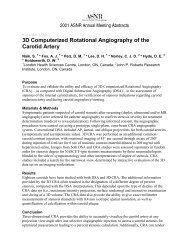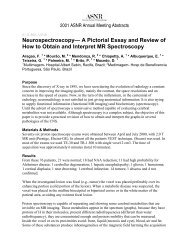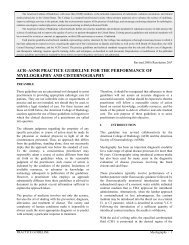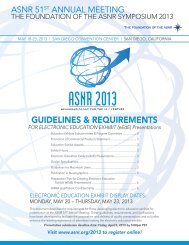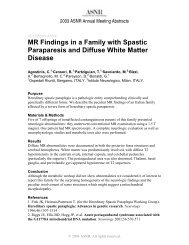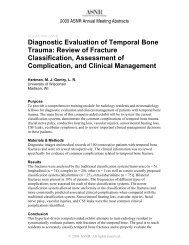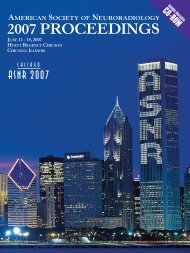acr–asnr–assr–sir–snis practice guideline for the performance of ...
acr–asnr–assr–sir–snis practice guideline for the performance of ...
acr–asnr–assr–sir–snis practice guideline for the performance of ...
- No tags were found...
You also want an ePaper? Increase the reach of your titles
YUMPU automatically turns print PDFs into web optimized ePapers that Google loves.
any new methods <strong>for</strong> achieving <strong>the</strong> same end: vertebralaugmentation.A thorough review <strong>of</strong> <strong>the</strong> literature was per<strong>for</strong>med. Whenpublished data were felt to be inadequate, data from <strong>the</strong>expert panel members’ own quality assurance programswere used to supplement. Thresholds <strong>for</strong> qualityassurance have been updated in accordance with availabledata in <strong>the</strong> literature.Introduced by Galibert and Deramond et al in France in1987 [1], vertebroplasty entails injection <strong>of</strong> material into<strong>the</strong> weakened vertebra. Radiologic imaging has been acritical part <strong>of</strong> vertebroplasty from its inception. Mostprocedures are per<strong>for</strong>med using fluoroscopic guidance <strong>for</strong>needle placement and material injection or placement.The use <strong>of</strong> computed tomography (CT) has also beendescribed <strong>for</strong> <strong>the</strong>se purposes [2-3].Vertebral augmentation is an established and safeprocedure [1-2,4-21]. Two blinded, randomizedcontrolled trials failed to demonstrate an advantage in<strong>the</strong>ir study populations <strong>for</strong> vertebroplasty over a controlintervention <strong>for</strong> ei<strong>the</strong>r pain reduction or disabilityimprovement [22-23]. However, larger, non-blinded,prospective randomized controlled studies and o<strong>the</strong>rstudies <strong>of</strong> vertebral augmentation have shown its efficacy[24-36]. As with any invasive procedure, <strong>the</strong> patient ismost likely to benefit when <strong>the</strong> procedure is per<strong>for</strong>med inan appropriate environment by qualified physicians.These <strong>guideline</strong>s are intended to be used in qualityimprovement programs to assess vertebral augmentationprocedures. The most important processes <strong>of</strong> care are 1)patient selection, 2) per<strong>for</strong>ming <strong>the</strong> procedure, and 3)monitoring <strong>the</strong> patient. The outcome measures orindicators <strong>for</strong> <strong>the</strong>se processes are indications, successrates, and complication rates. Outcome measures areassigned threshold levels.Use <strong>of</strong> o<strong>the</strong>r technologies to treat patients <strong>for</strong> <strong>the</strong> sameindications should yield similar or better success rates andcomplication pr<strong>of</strong>iles.II.DEFINITIONSVertebral augmentation includes all percutaneoustechniques used to achieve internal vertebral bodystabilization.Vertebroplasty is a minimally invasive surgical orinterventional procedure, per<strong>for</strong>med by percutaneouslyinjecting radiopaque bone cement into a painfulosteoporotic or neoplastic compression fracture or apainful vertebral body weakened by any o<strong>the</strong>r etiology.Kyphoplasty is an image-guided percutaneous procedurethat creates a cavity within <strong>the</strong> bone that is <strong>the</strong>n filledwith material.Failure <strong>of</strong> medical <strong>the</strong>rapy is defined as:III.1. For a patient rendered nonambulatory due to painfrom weakened or fractured vertebral body, painpersisting at a level that prevents ambulationdespite 24 hours <strong>of</strong> analgesic <strong>the</strong>rapy.or2. For a patient with sufficient pain from weakenedor fractured vertebral body that physical <strong>the</strong>rapyis intolerable, pain persisting at that level despite24 hours <strong>of</strong> analgesic <strong>the</strong>rapy.or3. For any patient with weakened or fracturedvertebral body, unacceptable side effects such asexcessive sedation, confusion, or constipationdue to <strong>the</strong> analgesic <strong>the</strong>rapy necessary to reducepain to a tolerable level.OVERVIEWVertebral compression fractures are a common and <strong>of</strong>tendebilitating complication <strong>of</strong> osteoporosis [37-41].Although most fractures heal within a few weeks ormonths, a minority <strong>of</strong> patients continue to suffer pain thatdoes not respond to conservative <strong>the</strong>rapy [42-44].Vertebral compression fractures are a leading cause <strong>of</strong>nursing home admission. Open surgical fixation is rarelyused to treat <strong>the</strong>se fractures. The poor quality <strong>of</strong> bone at<strong>the</strong> adjacent unfractured levels does not provide a goodanchor <strong>for</strong> surgical hardware, and <strong>the</strong> advanced age <strong>of</strong>most affected patients increases <strong>the</strong> morbidity andmortality risks <strong>of</strong> major surgery.Initial success with vertebroplasty <strong>for</strong> treating aggressivehemangiomas [1,12] and osteolytic neoplasms [10,21] ledto extension <strong>of</strong> <strong>the</strong> indications to include osteoporoticcompression fractures refractory to medical <strong>the</strong>rapy [2,4-9,11,13-19]. Vertebral augmentation is currently beingused to treat a wide variety <strong>of</strong> osteolytic metastases andmultiple myelomas.Perioperative imaging that identifies <strong>the</strong> painful vertebralbody in concordance with <strong>the</strong> clinical examination isconsidered essential <strong>for</strong> <strong>the</strong> safe and effectiveper<strong>for</strong>mance <strong>of</strong> vertebral augmentation.IV.INDICATIONS ANDCONTRAINDICATIONSThe major indication <strong>for</strong> vertebral augmentation is <strong>the</strong>treatment <strong>of</strong> symptomatic osteoporotic vertebral bodyfracture(s) refractory to medical <strong>the</strong>rapy or vertebralbodies weakened due to neoplasia. Currently, <strong>the</strong>re is noindication <strong>for</strong> <strong>the</strong> use <strong>of</strong> vertebral augmentation <strong>for</strong>2 / Vertebral Augmentation PRACTICE GUIDELINE



